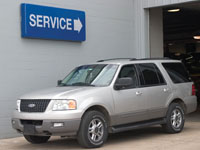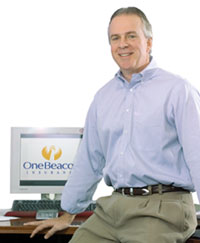
WINNING BIG IN SMALL COMMERCIAL
OneBeacon’s new OnePac product
is a “BOP package” for 300+ classes
By Elisabeth Boone, CPCU
 |
| OneBeacon Insurance executives include: (seated) Michael R. Keane, President; (from left) Travis M. MacMillian, Vice President/Marketing & Business Development; Chip Hamann, CPCU, Chief Underwriting Officer, OneBeacon Small Business; and Robert T. Cahill, CPCU, Vice President/Field Operations, OneBeacon Small Business. |
If you’ve been in the property/casualty business for more than 25 years, you probably remember when there was no such thing as a businessowners policy, or BOP. Main Street risks and other small commercial accounts were written on the CGL (which then stood for comprehensive general liability) form or on the CMP (commercial multi-peril) form. Local agents insured local businesses more as a matter of course than because small commercial was a hot market for carriers.
That was then; this is now. Today there’s probably no hotter market than small commercial, and insurers are aggressively competing for this business with a host of products that offer simplicity, flexibility, and plenty of bells and whistles.
Front and center in the popular small commercial market is OneBeacon, an A rated insurer that for the past two years has been building market share with its OnePac product. The base policy is a BOP-like package that can be customized for 12 target customer groups and more than 300 classes. A Web-based rating and policy issuance system helps agents close business at the point of sale.
The target groups for OnePac are:
• Apartment
• Auto services
• Building owners
• Condominium
• Hotel/motel
• Institutional (e.g., churches, synagogues)
• Manufacturing
• Office
• Restaurant
• Retail
• Servicing/processing
• Wholesaler/distributor
Standard coverage for most insureds includes replacement cost with no coinsurance, all-risk property coverage, equipment breakdown (except manufacturing program risks), and actual-loss-sustained business income. Each policy contains an amendatory endorsement that increases limits and adds coverages.
 |
 |
 |
Building a team
In 2001, the company known today as OneBeacon was acquired by White Mountains Insurance Group, Ltd., a Bermuda-based entity with holdings in property/casualty insurance and reinsurance. OneBeacon (formerly Commercial Union and General Accident, and later CGU), supported by its new management, undertook a number of initiatives aimed at establishing itself as a strong Northeastern regional carrier. A priority objective for OneBeacon was to strengthen its presence in the highly competitive market for small commercial risks.
Key players on the insurer’s small commercial team are Mike Keane, president of small business; Chip Hamann, chief underwriting officer; Travis MacMillian, head of marketing and business development; and Bob Cahill, who oversees field operations. Keane brings to his position a strong background in underwriting, sales, and field management with leading insurers. Hamann, who joined OneBeacon in 2002, originally was responsible for managing small package business. His initial efforts were focused on developing the OnePac system and product. Beyond that, he says, “My efforts have been directed at reconstituting our small business division and bringing back specialization and expertise to small business. We now have a full-fledged team focused on small business.”
Macmillian has two key responsibilities: state expansion for the OnePac product and related lines, and program and association business development. Cahill joined OneBeacon two years ago, bringing extensive small business experience gained with a national carrier. At OneBeacon, he is responsible for managing the small business unit’s new business and renewal underwriting centers.
Both of OneBeacon’s predecessors were active in the small commercial market, Hamann says. “We had some legacy products: a BOP and a small business package on the Commercial Union side, and a small package product written by General Accident. They were fine products from a coverage standpoint, but none of them was Web enabled,” he explains. “When we looked at where the marketplace was headed around the turn of the century, we realized that CGU was one of the few national carriers without a Web-enabled system. Even as a regional carrier after OneBeacon was formed, we were still one of the few companies that had no Web-based system.” As a result, Hamann comments, “we experienced some adverse selection because we were harder to do business with. Agents often would come to us after a risk had been declined by other markets. We continued to do business, but we clearly weren’t a vibrant small commercial market. That led us to conclude that we had to develop a Web-based system. That became OnePac.”
Just over a year ago, Mike Keane explains, “OneBeacon made the decision to carve out the small business within its commercial segment and dedicate both technological and human resources to creating a distinct business. We created a great field operations team with underwriting and marketing professionals, and we have our own technology group. The ability to break out small commercial and treat it as a distinct profit center in the OneBeacon family of companies has really been a great thing for us,” Keane says. “Our Web-based system enables us to get the product out faster and more efficiently, and we’re better able to support our agents.” In addition to speed and ease of processing, Hamann notes, “the new system gave us the flexibility to build the OnePac product exactly the way we wanted it.”
The OnePac product was launched in May of 2003 in Maine and is now available in several additional states: Massachusetts, Connecticut, New Hampshire, Rhode Island, Vermont, New York, New Jersey, Pennsylvania, District of Columbia, North Carolina, Illinois, California, and Oregon. Pending regulatory approval, the product is expected to be available shortly in Georgia, Virginia, and Washington state. “Our plan is to expand gradually into a select number of additional states, as time and resources permit,” Keane says. He emphasizes, however, that OneBeacon is firmly committed to maintaining the personality of a regional insurer, with the financial strength and resources of a national carrier.
“OneBeacon made the decision to carve out the small business within its commercial segment and dedicate both technological and human resources to creating a distinct business.”
—Michael Keane |
 |
Gaining an edge
As noted earlier, small commercial has become an intensely competitive market among both national and regional insurers. What do OnePac’s creators believe gives their product the advantage over competing policies? “Let me describe OnePac with one word: flexibility,” responds Travis Macmillian. “It offers flexibility to both our agents and potential policyholders. We can customize coverages to meet the needs of a specific insured. Our product looks like a BOP; it contains all the coverages that small business owners are accustomed to, like actual loss sustained, money and securities, and employee dishonesty, but it’s truly a package policy,” Macmillian explains. “The individual insured doesn’t end up buying coverages that are not needed. That allows us to price our product more competitively in the marketplace for the specific classes of business we want to target.”
With respect to agents, “One of the main drivers of small business is ease of use,” Macmillian says. “Our system is probably one of the easiest out there. Ours is not a simple rate and quote system; it’s an underwriting ‘smart’ system that allows agents to conduct business in a ‘once and done’ environment. Agents see real value in working with a system that has built-in eligibility and underwriting edits up front. The days when a ‘quick quote’ system was sufficient are over,” he comments. “Agents tell us they don’t want to find out that an account is ineligible or that the company can’t meet the quoted price after the sale. That’s embarrassing for everyone. Our program has great breadth in the number of classes and programs we offer,” Macmillian continues. “We try to give agents more opportunity to capitalize on the potential of the small business marketplace.”
Unlike other carriers, OneBeacon doesn’t define its small commercial segment in terms of premium. “We base it on product eligibility,” Macmillian explains. “On a per-location basis, we go up to about $5 million in sales, an average of about 25 employees, and square footage up to around 50,000. An agent knows right up front whether our product will fit a particular insured. If necessary, the agent can take a risk to our middle market team and place it there.”
Underwriting approach
The underwriting criteria for OnePac submissions are embedded in the Web-based system that supports the product. Hamann identifies some of the key considerations that govern the selection of insureds. “Like most small business carriers, we look first for relatively homogeneous classes, where one risk tends to look like another,” he says. “We have a broader appetite than some of our competitors; not everyone writes restaurants, manufacturers, apartments, or hotel/motel within a small package product.” Once a risk is determined to be eligible, “we can take a look at it. If it’s a really plain vanilla risk, like a law firm, a small office, or a light retail exposure, there’s a good chance it’ll go through our system without referral to an underwriter,” Hamann explains. “Many of the risks that are submitted come through without an underwriter touching them. The rest are referred to an underwriter for issues that relate to severity; specific risk characteristics like hurricane exposure; and less homogeneity, which is a concern with manufacturers because they tend to be our least homogeneous class of business.”
At that point, “the underwriter and the agent correspond through the system to obtain approval, and then the discussion moves to pricing,” Hamann says. “Here we do things a little bit differently from our competitors. As Travis mentioned earlier, our product looks like a BOP, but it’s a package. That means we can use split rating, where we rate the property and the general liability separately. That allows us to be more refined in our pricing than our competitors, and it also allows us to be broader in our appetite.”
OnePac underwriting, Cahill comments, is strongly focused on the needs of local agents and their clients. “It all starts with our territorial managers. These ‘small business experts’ set the local underwriting strategy, and they own the financial results in their territory. We try to keep our new business underwriters as close as possible to our agents. We have several new business centers throughout our territory, but all renewal underwriting is handled at our home office in Foxboro, Massachusetts.”
Another key piece of OneBeacon’s approach to small commercial business is a strong commitment to risk control. Risk control specialists can help insureds identify potential exposures and make safety recommendations, as well as gather additional risk information for underwriters. Losses are handled by community-based claims adjusters, and claims can be reported to the company after hours and on weekends.
Focus on agents
A total of 1,400 agencies represent OneBeacon, Keane says. Agents who write small commercial accounts are supported at the local level by territorial managers, at least one of whom is based in each state of OneBeacon’s operating territory. “Territorial managers are charged with developing their territory, establishing and nurturing our relationships with agents, training agents, and managing the mix of business both from a class standpoint and with respect to overall product mix between package, auto, and umbrella,” Keane explains. “Our territorial managers are far beyond the typical marketing rep. They are underwriting experts with a marketing and sales background, which gives them the ability to make decisions and truly manage the business from a local standpoint.”
For issues relating to appetite or coverage, agents can call either the territorial manager or the home office underwriting center.
“Once and done” processing
Over the last two years, OneBeacon has made the transition to a real-time, Web-based processing system that supports its OnePac business, Keane explains. “It has a complete policy administration system for package and auto business, and early in 2005 we’ll add umbrella business. The system can provide quick quotes on OnePac business, as well as full quotes. It has underwriting- and pricing-based logic, and it can issue policies,” he says. “As the agent is doing an initial submission, the system takes him or her through questions in the right order; and if the agent has a question during that process, the system has built-in help tips and customer support. Agents also can call our enterprise support center.
“The system supports new business and generates proposals; and also has automated renewal functionality,” Keane continues. “Our system also supports endorsements, so an agent can issue an endorsement or enter a policy change. We also support both cancellation and reinstatement.” What’s more, he adds, “The system has built-in interfaces with Marshall & Swift/Boeckh, Dun & Bradstreet, and other resources, which allows us to reduce the number of questions we have about a risk, to verify data, and to help the agent more accurately select limits and coverages for the insured.”
The OnePac processing system, Hamann remarks, is a “once and done” utility for agents that goes beyond systems that merely generate quotes. “Some of our competitors use strictly rating and issuance systems: You get a quote, and if you like the quote, the underwriting happens afterward, offline. Often an agent will present a number to an insured, the insured is happy, and then the underwriting process begins. We see more disadvantages than advantages in systems like that,” Hamann observes. “We take the opposite approach: Our system is an underwriting-based system, so we ask the questions up front. When the agent is finished, he or she has our final quote, and there’s no back and forth discussion later about whether we like the risk.”
What kind of feedback is the OnePac team getting from agents who write small commercial business? “The agency feedback about our system has been outstanding,” Hamann responds. “Agents prefer our system because it’s easier for them to use and much more efficient than other systems.”
Adds Keane: “The agents really appreciate our system’s endorsement capability because they save time by being able to issue their own endorsements. From a product standpoint, agents like the flexibility of OnePac. Agents clearly prefer the flexibility of a package, and they also like the fact that it starts like a BOP. The advantage of a BOP is that the agent doesn’t have to worry about including certain coverages,” Keane observes. Agents also like the fact that if an insured doesn’t want a certain coverage, it can be deleted, or coverage can be increased if the insured wants a higher limit.” That flexibility works both ways, Keane says. “There may be a situation where our underwriter is willing to write coverage only if we exclude certain components.”
Agents also value the breadth of OneBeacon’s appetite for small commercial risks, MacMillian comments. “If they use OnePac with OneBeacon, they only have to come to one place, and our once and done system is a huge advantage,” he says.
Looking ahead, Keane says, “As we continue to build and refine our product and its delivery, our overall goal is to provide a comprehensive insurance product for small business owners. We’ve built our product around those customers, and we’ve built our delivery system around independent agents, because they’re our real customers in this enterprise. The easier we make it for agents to do business with us, the more likely we are to become their market of choice—and that’s really what we’re trying to accomplish.” *
For more information:
OneBeacon Insurance
Web site: www.onebeacon.com